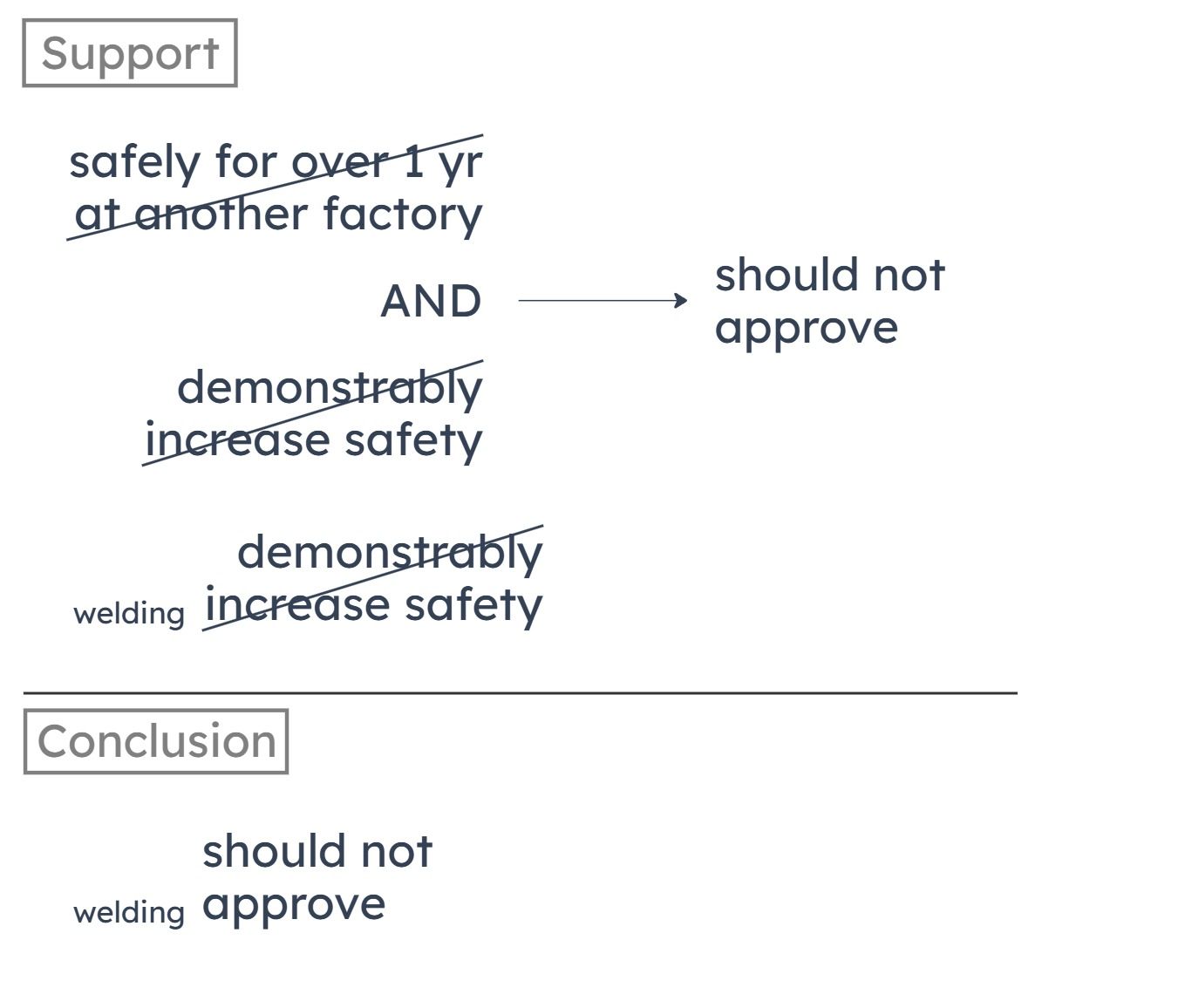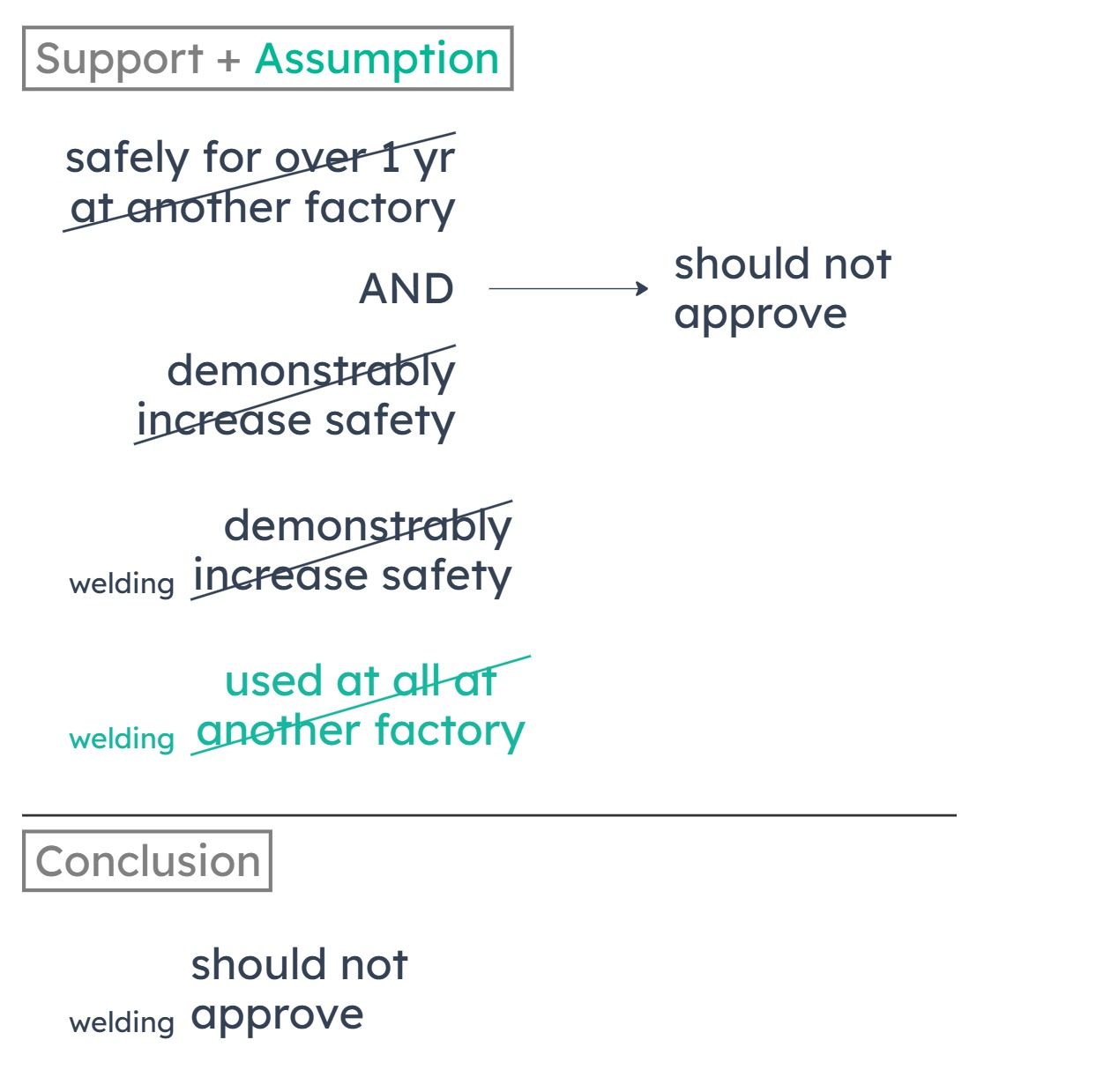Summarize Argument
The author concludes that teaching assistants should not be considered university employees. This is based on an intermediate conclusion that the sole purpose of having teaching assistants is to enable them to fund their education. The intermediate conclusion is based on the fact that if teaching assistants were not pursuing their degrees at university, or if they could otherwise already pay for their education, they wouldn’t have the teaching assistant jobs.
Notable Assumptions
The author assumes that TA’s inability to fund their education without having the TA position implies that the only purpose of the position is to help the TAs. (This overlooks that the university might have multiple purposes behind the TA position, one of which could be to use them as they would use employees.)
A
The administrator is cognizant of the extra costs involved in granting employee benefits to teaching assistants.
What the administrator is or is not aware of has no bearing on the administrator’s argument. You’d be making an ad hominem fallacy if you think that what she is personally aware of concerning costs should affect how we evaluate her argument.
B
The university employs adjunct instructors who receive compensation similar to that of its teaching assistants.
The fact there are other employees who receive similar compensation doesn’t suggest that the purpose of having TAs isn’t what the administrator claims. The argument’s reasoning isn’t based on how much TAs are paid compared to others.
C
The university has proposed that in the interest of economy, 10 percent of the faculty be replaced with teaching assistants.
This helps suggest that there’s more than one purpose to TAs. If the university is trying to replace faculty employees with TAs to save money, then at least part of the purpose of TAs is related to cost-savings. That means the “sole” purpose isn’t just to help the TAs.
D
Most teaching assistants earn stipends that exceed their cost of tuition.
Funding education can require more than just paying tuition. So the fact TAs earn more than tuition is consistent with the claim that the purpose of having TAs is to allow them to fund their education.
E
Teaching assistants work as much and as hard as do other university employees.
The argument concerns the purpose of having TAs and whether that purpose justifies treating them as employees. How hard the TAs might work isn’t relevant to the relationship between the TA’s purpose and their status as employees.
Summarize Argument: Counter-Position
Critics argue that Sauk’s work doesn’t have aesthetic merit, because it uses certain symbolic motifs of an artist that Sauk followed, but to further a political ideal that that artist would disagree with. The author rejects the critics argument, because the critics haven’t shown that the use of the same symbolic motifs for a purpose that the artist would reject would decrease aesthetic merit of Sauk’s work.
Describe Method of Reasoning
The author criticizes the critics’ argument by pointing out that the critics’ premise, even if it’s true, doesn’t provide any support to the critics’ conclusion. The fact Sauk uses the same symbolic motifs hasn’t been shown to affect the aesthetic merit of Sauk’s work.
A
the claims made in support of this conclusion are inaccurate
The claim made in support of the critics’ conclusion is that Sauk’s work uses symbolic motifs in service of politics that are different from those of the person Sauk imitated. The author doesn’t disagree with this claim. He disagrees that this claim is relevant to the conclusion.
B
Sauk’s work has aesthetic merit
The author’s argument doesn’t rely on the grounds that Sauk’s work has aesthetic merit. It relies on the grounds that it hasn’t been shown that imitating symbolic motifs that the original artist would disagree with decreases aesthetic merit of a work.
C
these critics are motivated by antipathy toward Sauk’s political ideas
The author never alleges that the critics are motivated by antipathy. Although he acknowlges that the critics would reject Sauk’s politics, that doesn’t mean this difference of political opinion motivates the critics in their argument.
D
the claims made in support of this conclusion have not been shown to be correct
The claim made in support of the critics’ conclusion is that Sauk’s work uses symbolic motifs in service of politics that are different from those of the person Sauk imitated. The author concedes that this is true (line beginning “Granting...”).
E
the claims made in support of this conclusion have not been shown to be relevant to it
The author believes the fact Sauk imitated an artist who would disagree with Sauk’s politics hasn’t been shown to decrease aesthetic merit. Thus, it hasn’t been shown to be relevant to the critic’s conclusion that Sauk’s work lacks aesthetic merit.
Application: The safety inspector should not approve the proposed new welding process, for it cannot be shown to increase safety at the factory.
Summary
The conclusion is that the factory’s safety inspector should not approve the proposed new welding process. This is based on the following:
In order for it to be appropriate to approve a new manufacturing process, it must (1) have been used safely for more than a year at another factory, OR (2) demonstrably increase safety at the factory at which the process will be implemented.
The new welding process can’t be shown to increase safety at the factory.

In order for it to be appropriate to approve a new manufacturing process, it must (1) have been used safely for more than a year at another factory, OR (2) demonstrably increase safety at the factory at which the process will be implemented.
The new welding process can’t be shown to increase safety at the factory.

Missing Connection
We know requirement (2) can’t be satisfied. But (1) might still be satisfied, in which case, it might be appropriate to approve the new welding process. To establish that the new welding process should NOT be approved, then, we want to establish that requirement (1) can’t be met, either. We want an answer that proves the new process has NOT been used safely for more than a year at another factory.
A
The factory at which the new welding process was first introduced has had several problems associated with the process.
This doesn’t establish that the new process hasn’t been used safely at another factory. First, we don’t know whether the “problems” in (A) are safety problems. Second, even if they are, the process could have been used safely at another factory besides the one at which the process was first introduced.
B
The proposed new welding process has not been used in any other factory.
(B) establishes that the new process has not been used safely for more than a year at another factory. After all, if it’s never been used in another factory, then it must be true that it hasn’t been used safely (or unsafely) at another factory.

C
Some of the manufacturing processes currently in use at the factory are not demonstrably safer than the new welding process.
How the new process compares to current processes has nothing to do with the policy that we’re trying to apply. (C) doesn’t establish that the new process hasn’t been used safely more than a year at another factory.
D
The safety inspector will not approve any new process that has not been used extensively elsewhere.
What the safety inspector will not approve has nothing to do with whether they SHOULD approve the new process. (D) doesn’t establish that the new process has not been used safely for more than a year at another factory.
E
The proposed new welding process has been used in only one other factory.
If that process has been used safely at that one factory, then it might be appropriate to approve the process. (E) does not establish that the new process has not been used safely for more than a year at another factory.
Summarize Argument
The author concludes that there must be good reason to think the defendant is not completely innocent. This is based on the author’s belief that the prosecutor would not have brought charges if the defendant were completely innocent.
Identify and Describe Flaw
The author assumes that the charging decision of the prosecutor constitutes evidence that the defendant isn’t completely innocent. This overlooks the possibility that the charging decision might indicate nothing about the defendant’s guilt. For example, perhaps the charging decision is based on mistaken or fraudulent evidence. Or maybe the decision is corrupt and merely used to threaten and harass the defendant. We simply have no idea whether the charging decision is indicative of guilt.
A
takes lack of evidence for a view as grounds for concluding that the view is false
The author’s premise is that the prosecutor brought charges. It’s not asserting a lack of evidence for the view that the defendant is innocent.
B
presupposes as evidence the conclusion that it is trying to establish
(B) describes circular reasoning. The author’s conclusion isn’t presupposed as evidence. The conclusion is that the defendant is not completely innocent. The evidence is the fact that the prosecutor brought charges. These aren’t the same idea.
C
places undue reliance on the judgments of an authority figure
The author places undue reliance on the charging decision of the prosecutor. There’s no compelling reason to believe that the defendant is guilty simply because of the prosecutor’s judgment that the defendant is guilty. We have to evaluate the evidence.
D
confuses legal standards for guilt with moral standards for guilt
It’s not clear whether the author means innocent in a legal sense or a moral sense, but regardless, it doesn’t matter, because the author never shifts between the two ideas. The flaw isn’t based on the difference between legal/moral standards.
E
concludes that a judgment is suspicious merely on the grounds that it was reached quickly
The author doesn’t argue that the jury’s decision is suspicious because it was reached quickly.